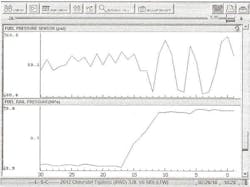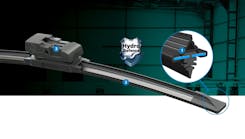Gasoline direct injection (GDI) introduces the fuel charge directly into the combustion chamber instead of via an intake runner. GDI systems differ in terms of operation and operating voltages. Servicing these systems involves diagnostic and repair challenges and precautions unique to GDI. In this article, Bill Fulton offers insight to aid in understanding these issues.
For those of you who can recall when the manufacturers first came out with the port fuel injected systems, you will remember it wasn’t long before we saw some predictable problems surface on these vehicles, such as olefin and diolefin buildup on the pintle area of the injector causing a restriction.
We have all done the chemical cleaning process through the injector rail to improve or eliminate the common lean conditions. In addition, carbon buildup on the back of the intake valves was also a common problem. If you can recall, the European manufacturers used a walnut shell blasting unit to clean these valves.
With the introduction of deposit resistance injectors (DRI), the pintle restriction has been greatly improved, but not completely eliminated. Due to the efforts by the American Petroleum Institute (API), the Society of Automotive Engineers (SAE) and the Environmental Protection Agency (EPA), modern-day top-tiered gasoline detergent additives have been increased to nearly eliminate this problem.
Have you noticed over the last few years that when the OE manufacturers come out with a new system, there always seems to be new problems that surface over time and mileage? That’s truly the case here when addressing the modern-day gasoline direct injected (GDI) systems. But before we address these predictable problems, let’s look at the dynamics of these systems.
The fuel tank
Let’s begin at the fuel tank. There is a low side supply side and a high pressure side of the GDI systems. There are two systems known as mechanical returnless systems and electronic returnless systems. On the mechanical returnless systems the supply side fuel pressure regulator is in the tank and part of the fuel pump module. To my knowledge, GM is the only manufacturer that still supplies a conventional fuel pressure test port to check for low side supply pressure with the conventional fuel pressure test port. Go figure. Ford supplies some through model year 2010, only to eliminate it in model year 2011. A T-fitting adapter can be purchased from the OTC people to manually use your conventional fuel pressure test gauge. Normally, the low side supply pressure will usually range between 50 to 60 psi. The interesting thing is that the GDI systems are designed to actually start and run from low side pressure, albeit not very well.
Even before returnless systems were introduced, the probability of having a fuel pressure test port has decreased over the years. If you can recall, the Honda PGMFI systems had a tab in the fuel pressure pulsator that would extend when system pressure was reached. On other systems it was truly a challenge to figure out how to manually test fuel pressure.
On the Ford electronic returnless systems, there is no fuel pressure regulator. Fuel pressure is controlled electronically by a fuel pump control module. The control module hammers the pump with system voltage or ground side controls the pump at 9,500 times a second. The PCM sees the engine load and increases the duty cycle signal to the fuel control module circuit.
The GM fuel pump control module will supply system voltage to the pump at 25,000 times a second. When the fuel pump control module wants to increase the low side pressure it simply increases the on time on a duty cycle scale to the pump. At any engine load condition the frequency signal never changes, but the duty cycle signal will increase as engine load and demand for low side fuel pressure increases. The PCM reads the engine load and uses the bus circuit to communicate this duty cycle signal to the fuel pump control module.
These duty cycle signals can be seen from the scan tool. As engine load increases so, too, will this signal. In addition, on GM systems there are two new scan tool parameters that are valuable in detecting weak or bad fuel pumps. They are known as short term fuel pump trim and long term fuel pump trim. If all is well on the low pressure supply side the values will be very close to 1.
Having numbers above 1 means the fuel pump control module is increasing the duty cycle command to keep the low pressure readings within spec.
Numbers below 1 indicate that the fuel pump control module is reducing the duty cycle signal again to keep low side fuel pressure within specs (see Figure 1).
The Ford electronic returnless systems also use a fuel pump control module. The Ford PCM reads the engine load and communicates a fuel pump control (FPC) signal in a duty cycle scale. For example, let’s say at idle under no-load conditions, your scan tool indicates a 30% duty cycle command from the PCM to the fuel pump control module. The Ford fuel pump control module will internally double this value and turn the pump on 60% on and 40% off. The voltage to the pump from the fuel pump control module is sent at 9,500 times a second. Ford fuel pumps are either ground side controlled or feed side controlled by the fuel pump control module.
Obviously, as engine load increases, the duty cycle signal is increased but the frequency signal remains constant. On both Ford and GM systems the fuel pump control modules have the responsibility of detecting electrical faults and relaying these to the PCM. The Ford systems use a dedicated fuel pump monitoring (FPM) circuit to communicate these faults. The GM systems will use the two wire high speed bus circuit for communication between the PCM and the fuel pump control module. The good news is that on these electronic returnless systems, there is a three-wire low pressure sensor that reports low side fuel supply to the fuel pump control module, meaning that we can read this value from the scan tool.
Keep in mind that these systems actually came out as early as 1998 on a couple of Ford PFI systems. GM also used these systems as early as 2007 on some of their PFI systems. NOTE: On the Ford system, the fuel pump control module supplies the ground for the fuel pump and the module together. On the F-series pickup this aluminum-housed module in mounted to a steel cross member. Dissimilar metal corrosion takes effect and you lose the fuel pump ground. Ford actually has a TSB fix for this problem. On GDI systems you will have either version.
For initial diagnostics, supply side pressure to the high pressure pump must be checked first (see Figure 2). The top scan tool graphic is low side supply pressure at about 60 psi. The bottom graph is high side injector rail pressure. At frame 17 we did a WOT power brake condition. Note that the high side pressure reached 9.8 mega pascals. The conversion to psi is to multiply 9.8 X 145 equals 1,421 psi. Under WOT conditions at 5,000 rpm this pressure will exceed 2,000 psi.
The supply side system supplies low side fuel pressure to the high pressure pump that is driven from the camshaft. This high pressure pump has an integrated control solenoid that is controlled by the PCM. The solenoid is spring loaded open, and duty cycle controlled to close in order to raise high side pressure in the injector rail.
Ford uses four lobes on the camshaft whereas the other manufacturers use three lobes on the camshaft. A cam follower is used to mechanically connect the pump to the camshaft. When removing the pump always remove the cam follower and check for concave signs of wear where most likely the cam lobes are worn as well. This would prevent full piston travel of the pump, thus creating a loss of fuel pressure on the high side. This problem is well documented on some European vehicles.
In addition, a high side fuel pressure sensor mounted on the injector rail reports high side fuel rail pressure to the PCM. This PID is available on the scan tool. The scan tool will show the command signal to the control solenoid. GM shows this on-time in degrees of crank rotation, although I have seen some aftermarket scan tools convert this to a duty cycle scale (see Figure 3). The top scan graphic is the duty cycle signal from the PCM to the high pressure pump control solenoid in a duty cycle scale. The bottom scan graphic is the command to the high pressure pump control solenoid in degrees of crank rotation. At frame 10 we did a WOT power brake. Note the increase in both parameters. Ford and other manufacturers show this value in a duty cycle scale.
Depending on your scan tool you may be able to bidirectionally control this solenoid by commanding a higher on-time which should increase the high side pressure. Keep in mind you will have to bring up the rpm as you use this function in your bay. The control solenoids have very low resistance values, around .5 ohms, so the PCM will hammer the solenoid 6,000 times per second (on/off) to limit the current flow.
As with the fuel pump control, the PCM simply increases the on-time to ramp up high side pressure. The PCM on both systems supply both the voltage and ground for these solenoids. The circuit codes for these systems are very robust. To limit the current flow the signal is frequency controlled by the PCM. On GM vehicles if the high side pressure line is removed, replace it and do not reuse it. Ford says that if the high side fuel pressure sensor is removed, it must be replaced with a new one.
Lean conditions are a common problem from a bad high pressure pump. In addition there have been cases where the high pressure pump leaks fuel into the crankcase, so always check the oil level on these systems. Before breaking any fuel lines on these systems, either remove the fuel pump fuse or remove the fuel pump relay and crank the engine over until the engine stalls and high fuel pressure is relieved.
Before Ford came out with their GDI systems, they were using electronic returnless systems as early as 1998. On the injector rail is a three-wire fuel rail pressure sensor. It also had a vacuum line hooked to a manifold vacuum source. The engineering idea here is that the PCM can see the exact fuel pressure drop across the injectors. The rule is that for every 2 in. of vacuum, the tips of the injectors that are exposed to it will increase the pressure drop across the injectors 1 psi. For example, at 18 in. of vacuum, the pressure drop across the injectors will increase by 9 psi. If the rail pressure reads 35 psi, the scan tool will read 44 psi. The fuel pressure gauge readings and the scan tool fuel pressure readings will never be the same. One problem we have seen on these systems is that the sensors are known to leak fuel pressure into its vacuum source, causing rich conditions and negative fuel trim corrections. In this case, by unplugging the vacuum source and noting fuel trim values corrected verifies a leaking sensor.
On the GDI systems, the injectors cannot operate with 12 volts as in conventional PFI systems. The injectors are charged by capacitors inside the PCM with 65 volts. Two injectors are charged at a time but only one injector is supplied with a ground by the PCM via the sequential firing order of the injectors.
When diagnosing a no-start, where you have ignition and fuel pressure, the need to check the injector drive circuit would be necessary. Noid lights and test lights would not work. In addition, access to the injectors would require a top engine tear-down.
The easy access would be at the PCM or at the wiring harness. When viewing a voltage trace, a two-channel scope would be needed. One channel would go to one wire to the injector while the other channel lead would go to the other wire.
During cranking you would see 65 volts on both channels. When the PCM wants the injector to be energized, the PCM will again supply the ground (see Figure 4). A low inductive current probe was clamped around the injector control wire. The amperage values on these GDI injectors vary between 8 and 12 amps. On this GM GDI system peak current flow reached 12 amps before the PCM modulates the ground to limit the current flow. The voltage trace on the right shows that the PCM capacitively charged the injector with 65 volts. The resistance values of the GDI injectors are very low in the range of 1.5 ohms. Removing the injectors will require a small slide hammer tool. In addition, a bore brush would be needed to clean the injector bore. Remember, the injector is inserted into the combustion chamber, so you must replace the seal. A special tool is needed to install a new injector compression seal.
There are some common problems on these GDI systems that have started to surface. Number one is carbon buildup on the tip of the injector causing a reduced and distorted injector spray pattern resulting in a lean density misfire.
The number two problem is carbon deposit buildup in the combustion chamber which can raise the compression ratio and can glow red hot causing spark knock. Most modern GDI systems will retard spark timing per cylinder in the event that detonation is detected from individual cylinders. On GM systems you will have scan data for this problem from each individual cylinder.
The third most common problem involves carbon buildup on the back of the intake valves. Remember, we no longer have the solvent effect from fuel pulsed to the back side of the intake valves. This problem is caused by crankcase fumes from vaporized oil molecules sucked through the PCV system. Synthetic or semi synthetic oils reduce this possibility. Of course, we all have customers who neglect the recommended oil change intervals and the recommended specific type of oil.
The fourth problem becomes more serious, with carbon deposit buildup in the top compression ring land of the piston. This prevents the top compression ring from expanding, resulting in blow-by and loss of compression.
In my opinion, these problems can be adequately addressed by an extended chemical soaking. The idea here is to allow an extended soaking period, as in overnight, to allow the chemical to break the molecular bonding of the carbon.
Obviously, this will not remove all deposits, but by giving it an extended soaking period it will produce an improvement. For more info on this you may want to visit BGs website at www.BGprod.com. The BG people sell a three-can kit where one can is used to clean the injectors through the rail. The chemical known as 44K is sprayed through the intake to address the carbon buildup on the back of the valves. In extreme cases it will be necessary to remove the intake manifold’s upper plenum. Half of the intake valves will be closed. A few ounces of 44K are applied to the back of these intake valves. A minimum 15 minutes of soak time is needed. The kit comes with large wooden toothpicks to punch at the carbon and break it up.
In addition, a wire brush is also supplied to scrub the back of the intake valves. All of this can be viewed on BG’s website.
With the number of these vehicles increasing every year, these systems are going to come into your shop with some of these common problems. As it goes in our industry, “Show me a problem and I will show you an opportunity.” ■
Bill Fulton is the author of Mitchell 1’s Advanced Engine Performance Diagnostics and Advanced Engine Diagnostics manuals. He is also the author of several lab scope and drivability manuals such as Ford, Toyota, GM, and Chrysler OBD I and OBD II systems, Fuel System Testing, many other training manuals in addition to his own 101 Lab Scope Testing Tips. He is a certified Master Technician with over 30 years of training and R&D experience. He was rated in the top three nationally in Motor Service Magazine’s Top Technical Trainer Award and has instructed for Mitchell 1, Precision Tune, OTC, O’Reilly Auto Parts, BWD, JD Byrider, Snap-on Vetronix and Standard Ignition programs. You may have also seen Fulton in many Lightning Bolt Training videos and DVDs and read his articles in many auto service magazines. He currently owns and operates Ohio Automotive Technology, which is an automotive repair and research development center.


